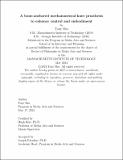A bone-anchored mechanoneural knee prosthesis to enhance control and embodiment
Author(s)
Shu, Tony
DownloadThesis PDF (20.49Mb)
Advisor
Herr, Hugh
Terms of use
Metadata
Show full item recordAbstract
To maximally utilize the peripheral nervous system for prosthetic control, it is necessary to first understand the compounded errors induced by amputated physiology before developing the appropriate interfacing technologies to extract any latent movement information. Through this work, I develop a foundational approach to amputation interventions and artificial interfaces applied toward neurorobotic control at the transfemoral level. The first part of this dissertation explores the neurophysiological and neuromechanical outcomes of a revisional transfemoral amputation that restores agonistantagonist muscle dynamics. A within-subjects study is performed to investigate changes in muscular function and cortical activity as a result of the intervention. Through these data, I provide evidence that extant amputated musculature can be modified to restore functionality for the purpose of efferent neurorobotic control. The second part of this dissertation explores a combined implementation of the revisional transfemoral amputation with a bone-anchored, or osseointegrated, transfemoral implant and chronically-implanted intramuscular electrodes. The clinical outcomes of the combined transfemoral platform are quantified through biophysical measurements and measurements of the stability of the implanted hardware to suggest the potential for bidirectional neurorobotic interfacing. The third part of this dissertation compares cohorts of persons with amputation possessing varied muscle architectures and physical interfacing configurations on the ability to produce physiological neurorobotic knee dynamics. Two subjects with the novel transfemoral platform are compared to the other cohorts without individual aspects of the platform, demonstrating unprecedented agility and sustainment of prosthetic embodiment in the process.
Date issued
2024-05Department
Program in Media Arts and Sciences (Massachusetts Institute of Technology)Publisher
Massachusetts Institute of Technology